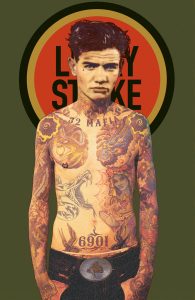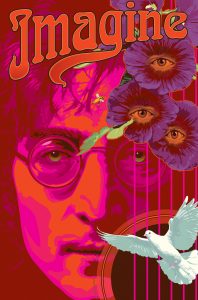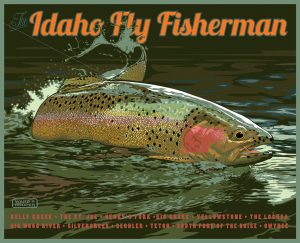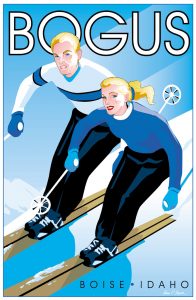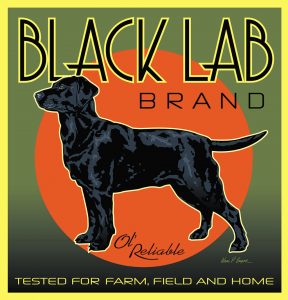Chances are, you’ve seen Ward Hooper art, even if you didn’t know it. Perhaps it was the dozens of posters celebrating Boise neighborhoods or Idaho resort towns. Perhaps it was the sculptures celebrating Basque culture bookending Boise’s Basque Block. Perhaps it was even one of the plaques denoting buildings on Boise’s geothermal system. They’re all his work, and that’s what makes him Idaho’s artist.
“Ward Hooper helps visually shape and inform our community identity,” said Karen Bubb, cultural planner in the Boise City Department of Arts & History, who has worked with Hooper on public art projects. “He connects our contemporary places, like the Basque Block, to a deeply-rooted historic past with his art. Ward is inspired by beautiful, historic design styles, which he makes his own applying them to places of meaning and memory for all of us.”
Karl LeClair, Boise’s public art program manager, voices a similar theme. “Ward has played an instrumental role in shaping the identity of Boise and its well-loved neighborhoods and resources such as our parks, the foothills open space, the Boise River and the Greenbelt, and also in representing important aspects of life here,” he explained. “Some of Ward’s work has become synonymous with our experience in Boise, sometimes without viewers or citizens even realizing it.”
Once you recognize Hooper’s style—it really is distinctive—you’ll see it everywhere.
“I’m drawn to things of a different era,” noted Hooper, 55, who owns an art and vintage clothing store downtown (Ward Hooper Vintage), where he creates art behind the counter. “I really like the old travel posters, art nouveau and art deco and things from the 1900s all the way to the 1940s and 1950s.”
An early job was working at a sign shop, which gave Hooper experience handling and arranging type. “You can see a lot of fonts and type in my work,” he said. “Words and the way they are put together graphically can also be a form of art.”
Another reason for Hooper’s ubiquity is just how much art he’s created. “When I started off, I was doing traditional painting,” he said. “I moved into airbrush because I liked that style. Then, fortunately, the computer age merged with the artistic.” Converting to the computer—he uses a Power Mac running Adobe Illustrator and Photoshop—let him create his work more quickly, in as little as a week.
“It makes me more prolific than someone who has to labor over a canvas for months,” Hooper said. “Learning to draw things on the computer stepped up my game quite a bit.” Commercial availability of large-scale printers also helped, he added. “You cut out the middleman and go right to your clientele.”
Growing up in Grangeville, Hooper was recognized early on for his talent. “Literally from the second- or third-grade, they’d hand out a coloring sheet and everyone in the class would do the same basic picture,” he said. “When I got done, everyone seemed to think I had achieved more than your average second-grader. Given some kudos for what you’re doing can do nothing but help you with what you’re doing.”
But kids weren’t encouraged to become artists in Grangeville, so Hooper went on to Boise State University—just one of two in his class of 100 to do so—and studied art. What he really wanted to be was an illustrator. “Growing up in the 1970s and 1980s, illustrators were everywhere: album covers, magazines,” he said.
Unfortunately, that style fell out of favor, so in the early 2000s Hooper started doing traditional travel posters of Idaho’s resort areas. “You live in an area with beautiful scenery. It rivals the most beautiful places in the world, but I’ve never seen a travel poster for Idaho other than Sun Valley, so I thought, why not?”
That led to a grant from the City of Boise to develop bus-stop posters celebrating Boise’s history and neighborhoods. “Boise at the time didn’t have any artists or artwork romanticizing or glorifying the beautiful things about the city,” he said. “Just postcards with jackalopes and giant potatoes. “
Those posters led to commissions for event posters. “Any successful concept breeds more business,” Hooper added.
While Hooper still produces event posters in his inimitable style—“People expect a certain thing, so I have to stick to certain parameters,”—he’s been branching out into posters ranging from rock concerts to dog breeds. “I did the top 10 breeds, in ‘orange crate label’ style, graphic and colorful,” he said. “Suddenly people are like, ‘Can you do my dog in that style?’ I started doing all these breeds I’d never heard of.”
It’s all part of how Hooper challenges himself as an artist. “I was able to find a niche, and make it a bigger niche, and people have latched onto me,” he explained. “I’m a staple here, part of the scenery.”


